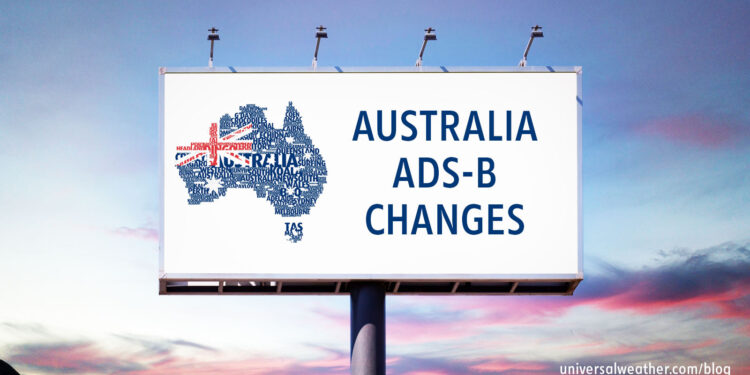Upcoming ADS-B Requirements in Australian Airspace

As part of an ongoing national focus towards safe and efficient air traffic management, and in light of strong growth in air traffic and passenger volumes, Airservices Australia has begun the mandated rollout of the Automatic Dependent Surveillance – Broadcast (ADS-B) system.
The following is an overview of what you need to know:
1. Benefits of ADS-B
The ADS-B system is intended to replace existing conventional and somewhat limited radar systems and provide aircraft pilots and air traffic controllers with real-time air traffic positional information via their display screens.
Similarly, it is expected to provide the following benefits:
- Surveillance-based separations standards, which can be less restrictive than non-surveillance separation tolerances.
- Increased likelihood of operation at preferred levels and on preferred routes.
- Reduced air-ground communications due to no requirement for position reporting.
- Enhanced safety net alerting.
- Potential for an improved SAR response where the aircraft position is accurately known (Airservices Australia, 2012).
2. Scheduled rollout for ADS-B in Australia
Currently, many private and business jet operators have yet to embrace the ADS-B system, with approximately only 5% of light aircraft operators adopting the new technology per Airservices Australia.
However, as of August 16, 2012, the Australian Civil Aviation Safety Authority (CASA) issued directives for a phased rollout and requirement for all Australian Instrument Flight Rules (IFR) aircraft to be equipped for ADS-B by February 2, 2017.
As such, in the coming months there are some important dates to be aware of.
From December 12, 2013, ANY AIRCRAFT that plans to operate AT OR ABOVE Flight Level (FL) 290 within Australian territory must carry serviceable ADS-B transmitting equipment that complies with an approved equipment configuration, unless specific approval of an exemption is granted (Aeronautical Information Package Supplement H96/12).The approved equipment configuration is laid out explicitly by the Australian Civil Aviation Safety Authority (CASA) and can provide further information as to whether or not your equipment is compliant.
3. Approved avionics equipment
The new requirements make fitment and operation of approved ADS-B avionics equipment mandatory on, and from, December 12, 2013 for ALL Australian aircraft operations at, or above, FL 290 (unless CASA has authorised otherwise).
Currently, compliant equipment is defined as follows:
ADS-B transmitting equipment must be of a type that:
- Is authorized by:
- The Federal Aviation Administration (FAA) in accordance with TSO-C166 as in force on September 20, 2004, or a later version as in force from time to time; or
- CASA, in writing, in accordance with:
- ATSO-C1004a as in force on December 16, 2009, or a later version as in force from time to time; or
- ATSO-C1005a as in force on December 16, 2009, or a later version as in force from time to time; or
- Meets the following requirements:
- The type must be accepted by CASA as meeting the specifications in RTCA/DO-260 dated September 13, 2000, or a later version as in force from time to time; and
- The type must utilise HPL at all times HPL is available; or
- Is otherwise authorized, in writing, by CASA for the purposes of subsection 9B of this Civil Aviation Order as being equivalent to one of the above types.
4. Brands and models of equipment that are known to meet the standards and work in Australia
CASA AC 21-45(1) lists a number of products already approved and used in Australia for IFR aircraft. The following additional products are also known to be suitable as given on the Airservices Australia website:
Transponders
- Garmin GTX 330ES and 33ES
- TRIG TT31, TT22 and TT21
GPS position sources
- Garmin GTN750
- FreeFlight 1201, 1203
- Accord NexNav
- Garmin GPS/GNS 400/500W series
- Garmin GTN 650/750 series
5. Information that must be transmitted
Should an aircraft carry serviceable ADS-B transmitting equipment for operational use in Australian territory, the equipment must transmit:
- a flight identification that corresponds exactly to the aircraft identification mentioned on the flight notification filed with, or relayed to, Air Traffic Control (ATC) for the flight; or
- if no flight notification is filed for the flight and the aircraft is registered by a National Airworthiness Authority (NAA) – a flight identification that is the aircraft’s nationality or common mark, and its registration mark, without any hyphen included; or
- Another flight identification directed or approved by ATC.
As such, the equipment must be operated continuously during the flight in all airspace at all altitudes unless the pilot is directed or approved otherwise by ATC (Civil Aviation Order 82.1).
6. Exemption options
Operators can request exemption via CASA for the special east coast radar area and controlled terminal areas, extending from 200 nautical miles (NM) north of Cairns to 200 NM west of Adelaide. Exemptions are available for these areas only. You can find a chart on the Australian Government ComLaw website that outlines these areas (found at the end of the text area on the site).
In order to apply for an exemption for the areas noted above, the operator must complete the CASA Form 208: Notification to operate aircraft without ADS-B in defined areas of airspace.
Notifications must be submitted a minimum of 14 days prior to commencement of operations and will remain valid until December 11, 2015.
11/14/2013: Update by author
Conclusion
While these requirements may appear initially perplexing, it’s recommended that you speak to your ground handler or 3rd-party provider with any inquiries you might have, or ask them to direct you to the appropriate authority should you wish to seek dispensation, exemption or further clarification. It’s important to note that the requirements for such exemptions are potentially restrictive.
Questions?
If you have any questions about this article or need assistance with business aircraft operations in Australia, contact christinevamvakas@univ-wea.com.




